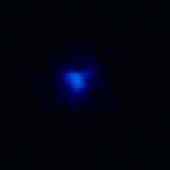ESA Science & Technology - News Archive
News archive
News archive
A colourful design capturing the essence of ESA's CHEOPS mission, which will measure the size of planets as they cross in front of their parent stars, has been selected for the rocket carrying the satellite into space.
Published: 29 March 2018
An international team of researchers using the NASA/ESA Hubble Space Telescope and several other observatories have, for the first time, uncovered a galaxy in our cosmic neighbourhood that is missing most – if not all – of its dark matter.
Published: 28 March 2018
The James Webb Space Telescope is undergoing final integration and testing that will require more time to ensure a successful mission. Following a new assessment of the remaining tasks on the highly complex space observatory, the launch window is now targeted for about May 2020.
Published: 27 March 2018
Meet ESASky, a discovery portal that provides full access to the entire sky. This open-science application allows computer, tablet and mobile users to visualise cosmic objects near and far across the electromagnetic spectrum.
Published: 22 March 2018
Last month, ESA's Gaia satellite experienced a technical anomaly followed by a 'safe mode' event. After thorough examination, the spacecraft was successfully recovered and resumed normal scientific operations, while the mission team keeps investigating the exact cause of the anomaly.
Published: 21 March 2018
Galaxies are not static islands of stars – they are dynamic and ever-changing, constantly on the move through the darkness of the Universe. Sometimes, as seen in this spectacular Hubble image of Arp 256, galaxies can collide in a crash of cosmic proportions.
Published: 8 March 2018
The purpose of this Announcement of Opportunity (AO) is to solicit proposals for membership of the X-ray Astronomy Recovery Mission (XARM) Science Team as Participating Scientists. The deadline for submitting proposals has passed.
Published: 6 March 2018
Proposals are solicited for observations with INTEGRAL in response to the Sixteenth Announcement of Opportunity, AO-16. This AO covers the period January 2019 to December 2019. The deadline for proposals is 13 April 2018, 14:00 CEST.
Published: 5 March 2018
ESA's INTEGRAL space observatory has witnessed a rare event: the moment that winds emitted by a swollen red giant star revived its slow-spinning companion, the core of a dead star, bringing it back to life in a flash of X-rays.
Published: 5 March 2018
An international team of scientists has used the NASA/ESA Hubble Space Telescope to study the atmosphere of the hot exoplanet WASP-39b. By combining this new data with older data they created the most complete study yet of an exoplanet atmosphere.
Published: 1 March 2018
In 2014, ESA's XMM-Newton spotted X-rays emanating from the massive star Rho Ophiuchi A and, last year, found these to ebb and flow periodically in the form of intense flares – both unexpected results. The team has now used ESO's Very Large Telescope to find that the star boasts a strong magnetic field, confirming its status as a cosmic lighthouse.
Published: 26 February 2018
Beauty, grace, mystery – this magnificent spiral galaxy has all the qualities of a perfect galactic Valentine. Captured by the NASA/ESA Hubble Space Telescope, the galaxy NGC 3344 presents itself face-on, allowing astronomers a detailed look at its intricate and elegant structure.
Published: 14 February 2018
An international team of astronomers has used the NASA/ESA Hubble Space Telescope to look for atmospheres around four Earth-sized planets orbiting within or near TRAPPIST-1's habitable zone. The new results further support the terrestrial and potentially habitable nature of three of the studied planets.
Published: 5 February 2018
ESA's XMM-Newton has spotted surprising changes in the powerful streams of gas from two massive stars, suggesting that colliding stellar winds don't behave as expected.
Published: 2 February 2018
Following the release of the first catalogue in 2016, ESA's Gaia mission will publish its long-awaited map of more than 1 billion stars in our Galaxy on 25 April 2018.
Published: 25 January 2018
Resembling a swarm of flickering fireflies, this beautiful galaxy cluster glows intensely in the dark cosmos, accompanied by the myriad bright lights of foreground stars and swirling spiral galaxies. A1758N is a sub-cluster of Abell 1758, a massive cluster containing hundreds of galaxies.
Published: 18 January 2018
A riot of colour and light dances through this peculiarly shaped galaxy, NGC 5256. Its smoke-like plumes are flung out in all directions and the bright core illuminates the chaotic regions of gas and dust swirling through the galaxy's centre. Its odd structure is due to the fact that this is not one galaxy, but two – in the process of a galactic...
Published: 14 December 2017
Measuring the positions and motions of more than a billion stars, ESA's Gaia mission will refine our knowledge about our place in the Universe, providing the best ever star chart of our Milky Way and its neighbouring galaxies.
Published: 13 December 2017
Astronomers have used ESA's Herschel Space Observatory to solve a decades-old mystery about the origin of powerful cool gas winds in the hot environs of quasars. The evidence linking these powerful winds to star formation in the quasar host galaxies may also help resolve the mystery of why the size of galaxies in the Universe appears to be capped.
Published: 7 December 2017
A team of astronomers used data from both the NASA/ESA Hubble Space Telescope and ESA's Gaia satellite to directly measure the 3D motions of individual stars in a nearby galaxy.
Published: 27 November 2017
—
20 Items per Page




















